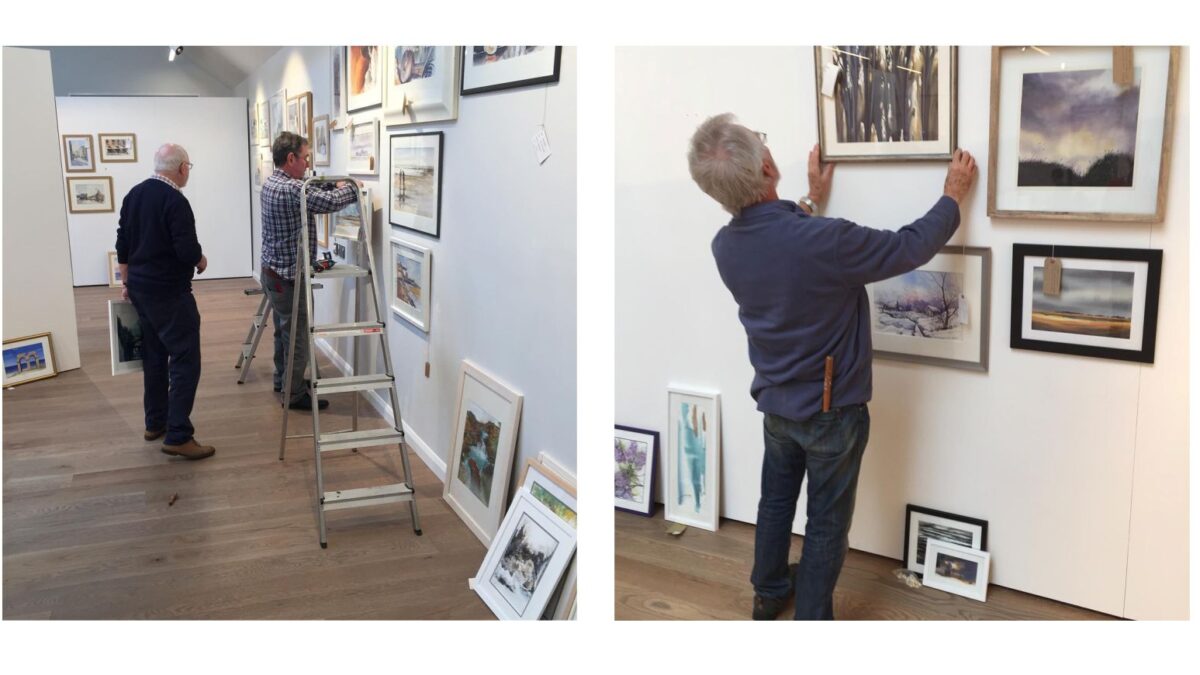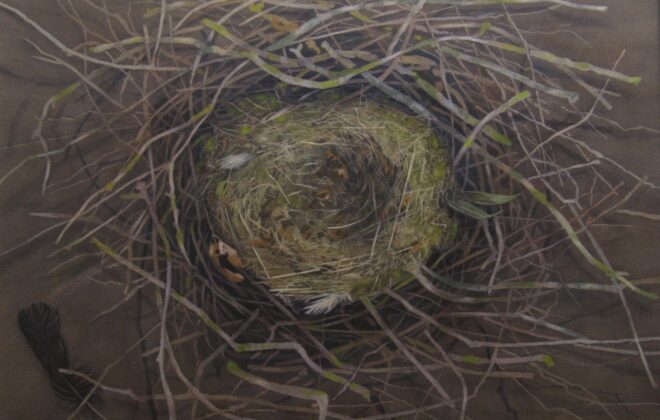Why does the society have a framing guide?
In the run up to our second Awash Festival of Watercolours, we have published a presentation guide for artists who will be displaying their work at the Festival and also for future exhibition. In this article we explore the reasoning behind the rules.
Framing, matting and glass
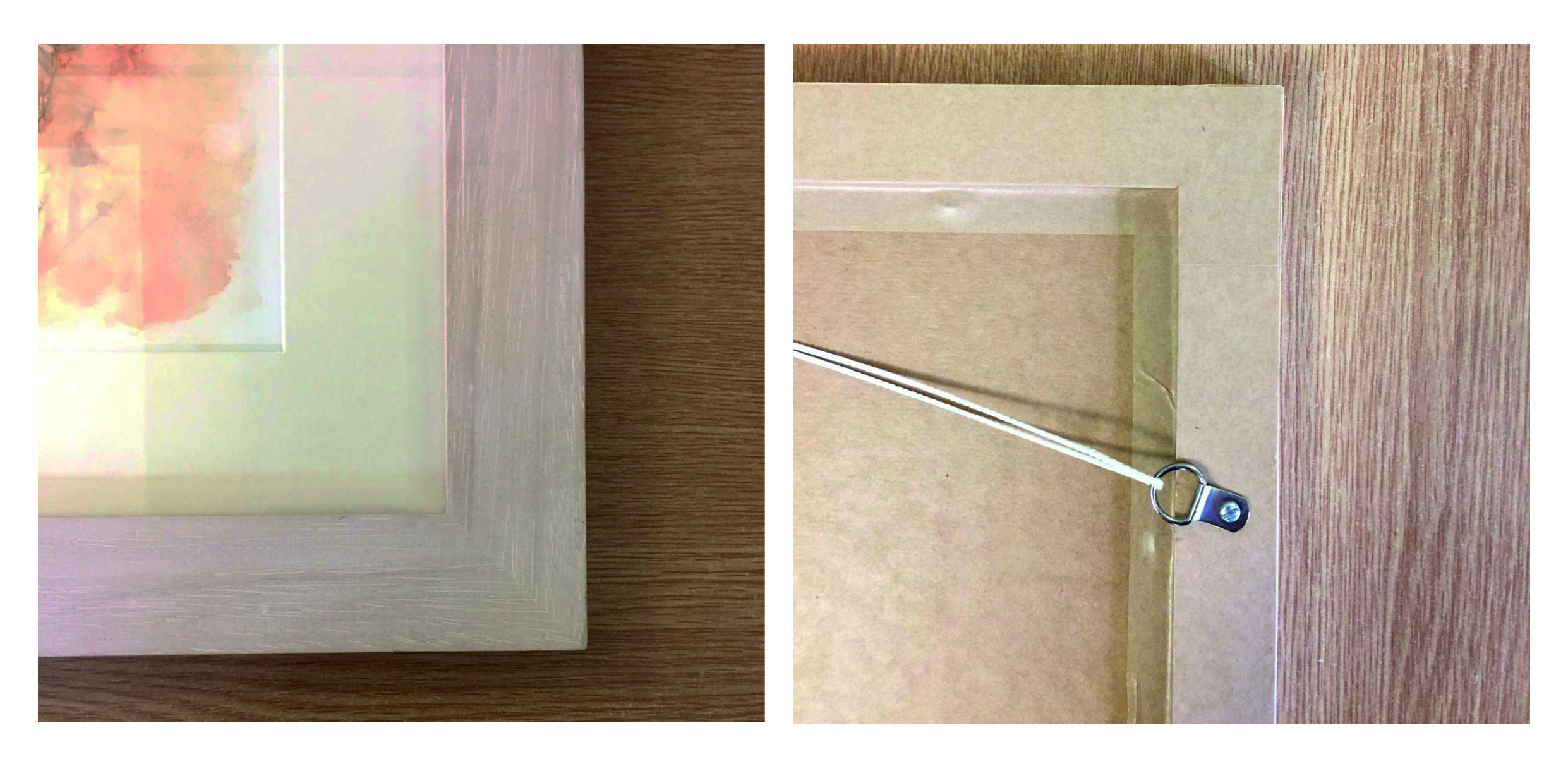 The aesthetic our society follows with its framing guideline (and its option to reject work) is commonly known as the Gallery Framing Aesthetic. By asking artists to conform to a low key colour palate for frames and mounts, the society is aiming for a unified aesthetic appeal for the entire exhibition. The artist only has to worry about the appeal of a few paintings, but the Awash hanging team has to worry about the overall look of over 200 paintings.
The aesthetic our society follows with its framing guideline (and its option to reject work) is commonly known as the Gallery Framing Aesthetic. By asking artists to conform to a low key colour palate for frames and mounts, the society is aiming for a unified aesthetic appeal for the entire exhibition. The artist only has to worry about the appeal of a few paintings, but the Awash hanging team has to worry about the overall look of over 200 paintings.
There is a financial advantage to opting for a simple frame, it gives the artist more budget to spend on good quality matting board, backing board and framing tape. The aesthetic advantage is two-fold: an elaborate frame and coloured matting might draw the eye to your painting, but it may also repel a potential buyer. In a group exhibition setting, having a simple frame standard makes the playing field even for all artists and also enhances the natural beauty of the paintings and allows them to speak for themselves. Think of a minimalist frame as a carrying case for your artwork. It is the “little black dress” of the art world – a classic that goes anywhere and suits any occasion.
One might wonder why glass is preferred as a covering over lighter materials like perspex. While perspex may be easier to carry and less likely to break – it also scratches very easily, gets charged with static and attracts dust.
The ban on corrugated cardboard, masking tape and cellotape, is one that protects your artwork. A good quality backing board, along with good quality framing tape adds a layer of protection against humidity, dust and other environmental factors. It also preserves our reputation as a society and your reputation as an artist. If a visitor has just paid for a painting that looks great on the front, how embarrassing would it be if they turned it over and discovered the back was a mess?
D-rings, cords and luggage tags
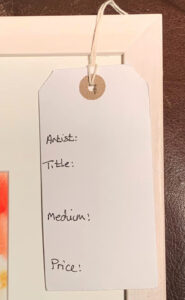 The society asks artists to include D-rings about a third of the way down the sides of the frame and a taut hanging cord. This seems very specific until you consider how difficult it is just to get one picture hung up at home. The hanging team are seasoned veterans, but they also spend a whole day getting the exhibition up. Preparation work done before the exhibition makes it easier for these unsung heroes to get your paintings up and looking their best. Imagine trying to hang nearly 200 paintings and none of them having consistent hardware with which to hang them? It would be a nightmare.
The society asks artists to include D-rings about a third of the way down the sides of the frame and a taut hanging cord. This seems very specific until you consider how difficult it is just to get one picture hung up at home. The hanging team are seasoned veterans, but they also spend a whole day getting the exhibition up. Preparation work done before the exhibition makes it easier for these unsung heroes to get your paintings up and looking their best. Imagine trying to hang nearly 200 paintings and none of them having consistent hardware with which to hang them? It would be a nightmare.
Similarly, the luggage tags remove one of the arduous tasks that the committee used to perform. At previous exhibitions, the committee used to have to check the back of each painting for its information after it was hung up, in order to place the correct label next to it. This takes a great deal of time, and can result in mistakes being made, or paintings being dislodged. Having a hanging tag makes labelling a complete breeze and ensures that your painting matches its gallery label.
Transporting
You might be asking what the fuss is when we insist on reusable art travel bags. There is a simple answer: time; and a more complicated answer: cost, waste, frustration and liability.
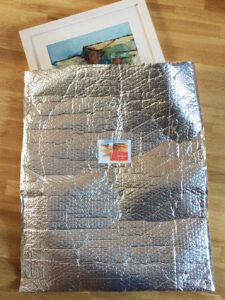
If you are transporting your own artwork to the exhibition and you want to use bubblewrap and tape, then you are welcome to do so, BUT you will have to do your own unpacking, and removal of the wrapping. You will need to ensure that you arrive with your own scissors to cut the tape and if your art is unsold, you will need to arrive with all your packaging supplies to re-wrap your art. None of the other members should be responsible for unpackaging or repackaging your art or being liable for any damage that might occur.
If, on the other hand your artwork is in a reusable and labelled bag, with an easily accessible opening, then someone else can delivery your artwork and bring your empty bags home with a minimum of fuss and risk to your painting. We have limited storage capacity at the gallery – so bags need to be removed on hanging day and returned (if necessary) on take down day.
As mentioned before – the Awash festival has just under 200 paintings submitted. Imagine having to try and wrestle that number of paintings out of their wrappings? There are bound to be casualties and probably a few choice curses flying around.
A reusable bag is an investment in your future exhibitions. It saves money in the long run, makes packing for exhibitions a breeze, and brings blessings from the hanging team on your head.
There are quite a few options on the market: ArtPakk; Stiffybags and others. Alternatively, if you know a good quilter, you could get a custom bag or two made.
All of our guidelines are aimed at presenting your art to its best advantage and hopefully attract a buyer, as well as make it easier for the hanging team to complete the mammoth task of hanging the exhibition. Help them and yourself to the best of your ability and if you can think of any other tips or tricks that will improve our exhibition preparation, do let us know!
A last thought before your roll up your sleeves to start framing: Don’t forget to sign your paintings!
Tags In
Search by category
Blog archive
- February 2023
- October 2022
- June 2022
- April 2022
- January 2022
- October 2021
- July 2021
- April 2021
- March 2021
- February 2021
- January 2021
- October 2020
- September 2020
- August 2020
- July 2020
- June 2020
- May 2020
- April 2020
- March 2020
- February 2020
- January 2020
- December 2019
- October 2019
- July 2019
- April 2019
- March 2019
- January 2019
- December 2018
- April 2018

